Nikon B700 vs P900
The Nikon Coolpix B700 and the Nikon Coolpix P900 are two digital cameras that were revealed to the public, respectively, in February 2016 and March 2015. Both the B700 and the P900 are fixed lens compact cameras that are equipped with a 1/2.3-inch sensor. The B700 has a resolution of 20.2 megapixels, whereas the P900 provides 15.9 MP.
Below is an overview of the main specs of the two cameras as a starting point for the comparison.

Check B700 offers at
ebay.com

Check P900 offers at
ebay.com
Going beyond this snapshot of core features and characteristics, what are the differences between the Nikon Coolpix B700 and the Nikon Coolpix P900? Which one should you buy? Read on to find out how these two cameras compare with respect to their body size, their imaging sensors, their shooting features, their input-output connections, and their reception by expert reviewers.
Body comparison
The side-by-side display below illustrates the physical size and weight of the Nikon B700 and the Nikon P900. The two cameras are presented according to their relative size. Three consecutive views from the front, the top, and the rear side are shown. All width, height and depth dimensions are rounded to the nearest millimeter.
The B700 can be obtained in two different colors (black, red), while the P900 is only available in black.
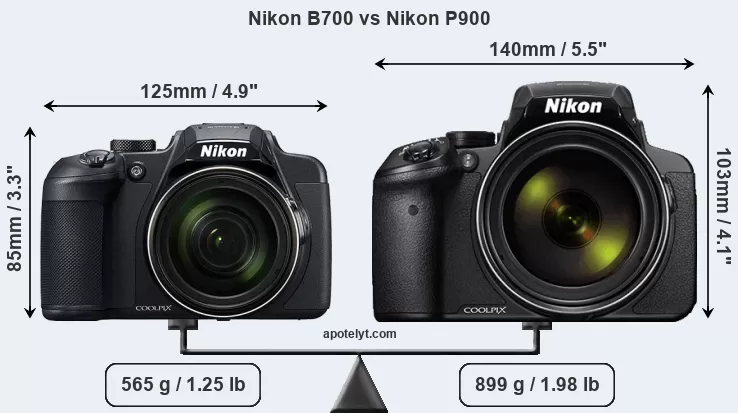
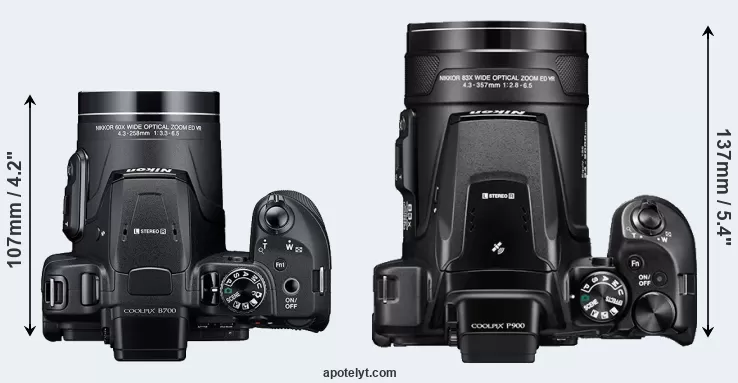
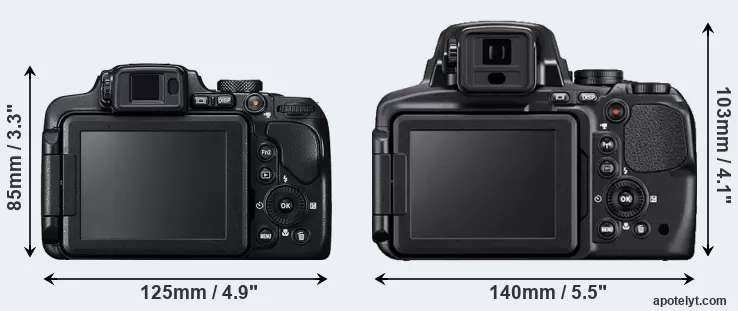
If the front view area (width x height) of the cameras is taken as an aggregate measure of their size, the Nikon P900 is notably larger (36 percent) than the Nikon B700. Moreover, the P900 is substantially heavier (59 percent) than the B700. In this context, it is worth noting that neither the B700 nor the P900 are weather-sealed.
The battery packs of both cameras can be charged via USB, which can be very convenient when travelling.
The table below summarizes the key physical specs of the two cameras alongside a broader set of comparators. In case you want to display and compare another camera duo, you can use the CAM-parator app to select your camera combination among a large number of options.

| Camera Model |
Camera Width |
Camera Height |
Camera Depth |
Camera Weight |
Battery Life |
Weather Sealing |
Camera Launch |
Launch Price (USD) |
Street Price |
||
|---|---|---|---|---|---|---|---|---|---|---|---|
| 1. | Nikon B700 | 125 mm | 85 mm | 107 mm | 565 g | 350 | n | Feb 2016 | 499 | ebay.com | |
| 2. | Nikon P900 | 140 mm | 103 mm | 137 mm | 899 g | 360 | n | Mar 2015 | 599 | ebay.com | |
| 3. | Canon SX70 | 127 mm | 91 mm | 117 mm | 608 g | 325 | n | Sep 2018 | 549 | amazon.com | |
| 4. | Kodak AZ901 | 139 mm | 104 mm | 119 mm | 777 g | 400 | n | Jan 2016 | 499 | amazon.com | |
| 5. | Nikon B500 | 114 mm | 78 mm | 95 mm | 541 g | 600 | n | Jan 2016 | 299 | ebay.com | |
| 6. | Nikon L840 | 113 mm | 78 mm | 96 mm | 538 g | 590 | n | Feb 2015 | 299 | ebay.com | |
| 7. | Nikon P950 | 140 mm | 110 mm | 150 mm | 1005 g | 290 | n | Jan 2020 | 799 | amazon.com | |
| 8. | Nikon P1000 | 146 mm | 119 mm | 181 mm | 1415 g | 250 | n | Jul 2018 | 999 | amazon.com | |
| 9. | Panasonic FZ80 | 130 mm | 94 mm | 119 mm | 616 g | 330 | n | Jan 2017 | 399 | ebay.com | |
| 10. | Panasonic ZS70 | 112 mm | 67 mm | 41 mm | 322 g | 380 | n | Apr 2017 | 449 | ebay.com | |
| 11. | Sony HX90V | 102 mm | 58 mm | 36 mm | 245 g | 360 | n | Apr 2015 | 429 | ebay.com | |
| 12. | Sony HX350 | 130 mm | 93 mm | 103 mm | 652 g | 300 | n | Dec 2016 | 449 | ebay.com | |
| 13. | Sony HX400V | 130 mm | 93 mm | 103 mm | 660 g | 300 | n | Feb 2014 | 499 | ebay.com | |
| Note: Measurements and pricing do not include easily detachable parts, such as add-on or interchangeable lenses or optional viewfinders. | |||||||||||
Any camera decision will obviously take relative prices into account. The listed launch prices provide an indication of the market segment that the manufacturer of the cameras have been targeting. The B700 was launched at a somewhat lower price (by 17 percent) than the P900, which makes it more attractive for photographers on a tight budget. Normally, street prices remain initially close to the MSRP, but after a couple of months, the first discounts appear. Later in the product cycle and, in particular, when the replacement model is about to appear, further discounting and stock clearance sales often push the camera price considerably down.
Sensor comparison
The size of the sensor inside a digital camera is one of the key determinants of image quality. A large sensor will generally have larger individual pixels that offer better low-light sensitivity, provide wider dynamic range, and have richer color-depth than smaller pixels in a sensor of the same technological generation. Further, a large sensor camera will give the photographer additional creative options when using shallow depth-of-field to isolate a subject from its background. On the downside, larger sensors are more costly to manufacture and tend to lead to bigger and heavier cameras and lenses.
Both cameras under consideration feature a 1/2.3-inch sensor and have a format factor (sometimes also referred to as "crop factor") of 5.6. Within the spectrum of camera sensors, this places the review cameras among the smaller-sensor digicams that favor affordability and compact design. Both cameras feature a native aspect ratio (sensor width to sensor height) of 4:3.
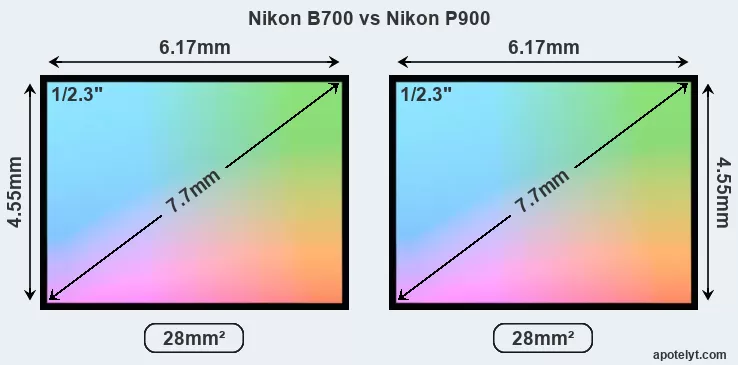
While the two cameras under review share the same sensor size, the B700 offers a higher resolution of 20.2 megapixels, compared with 15.9 MP of the P900. This megapixels advantage translates into a 13 percent gain in linear resolution. On the other hand, these sensor specs imply that the B700 has a higher pixel density and a smaller size of the individual pixel (with a pixel pitch of 1.18μm versus 1.33μm for the P900). In this context, it should be noted, however, that the B700 is a somewhat more recent model (by 11 months) than the P900, and its sensor might have benefitted from technological advances during this time that at least partly compensate for the smaller pixel size. Coming back to sensor resolution, it should be mentioned that neither of the two cameras has an anti-alias filter installed, so they are able to capture all the detail the sensor resolves.
The resolution advantage of the Nikon B700 implies greater flexibility for cropping images or the possibility to print larger pictures. The maximum print size of the B700 for good quality output (200 dots per inch) amounts to 25.9 x 19.4 inches or 65.8 x 49.4 cm, for very good quality (250 dpi) 20.7 x 15.6 inches or 52.7 x 39.5 cm, and for excellent quality (300 dpi) 17.3 x 13 inches or 43.9 x 32.9 cm. The corresponding values for the Nikon P900 are 23 x 17.3 inches or 58.5 x 43.9 cm for good quality, 18.4 x 13.8 inches or 46.8 x 35.1 cm for very good quality, and 15.4 x 11.5 inches or 39 x 29.3 cm for excellent quality prints.
The Nikon Coolpix B700 has a native sensitivity range from ISO 100 to ISO 3200. The corresponding ISO settings for the Nikon Coolpix P900 are ISO 100 to ISO 6400, with the possibility to increase the ISO range to 100-12800.
Technology-wise, both cameras are equipped with BSI-CMOS (Backside Illuminated Complementary Metal–Oxide–Semiconductor) sensors. Both cameras use a Bayer filter for capturing RGB colors on a square grid of photosensors. This arrangement is found in most digital cameras.
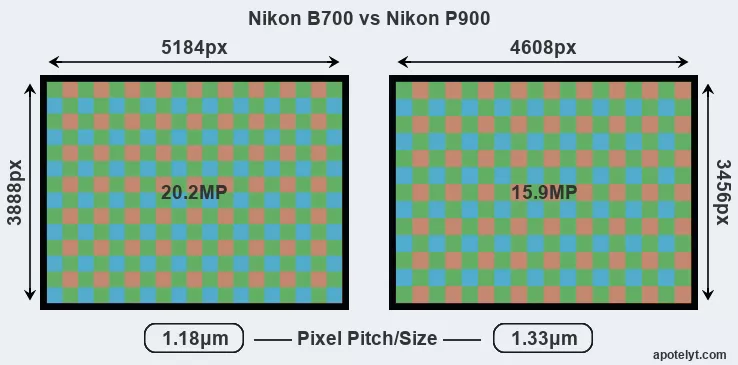
Since 2007, DXO Mark has published sensor performance measurements that have been derived using a consistent methodology. This service assesses and scores the color depth ("DXO Portrait"), dynamic range ("DXO Landscape"), and low-light sensitivity ("DXO Sports") of camera sensors, and also publishes an overall camera score. The adjacent table reports on the physical sensor characteristics and the outcomes of the DXO sensor quality tests for a sample of comparator-cameras.

| Camera Model |
Sensor Class |
Resolution (MP) |
Horiz. Pixels |
Vert. Pixels |
Video Format |
DXO Portrait |
DXO Landscape |
DXO Sports |
DXO Overall |
||
|---|---|---|---|---|---|---|---|---|---|---|---|
| 1. | Nikon B700 | 1/2.3 | 20.2 | 5184 | 3888 | 4K/30p | 20.4 | 11.8 | 818 | 48 | |
| 2. | Nikon P900 | 1/2.3 | 15.9 | 4608 | 3456 | 1080/60p | 20.2 | 11.6 | 727 | 47 | |
| 3. | Canon SX70 | 1/2.3 | 20.2 | 5184 | 3888 | 4K/30p | 20.6 | 12.1 | 1063 | 51 | |
| 4. | Kodak AZ901 | 1/2.3 | 20.2 | 5184 | 3888 | 1080/30p | 20.3 | 11.7 | 806 | 48 | |
| 5. | Nikon B500 | 1/2.3 | 15.9 | 4608 | 3456 | 1080/60i | 20.3 | 11.7 | 810 | 48 | |
| 6. | Nikon L840 | 1/2.3 | 15.9 | 4608 | 3456 | 1080/60i | 20.2 | 11.6 | 721 | 47 | |
| 7. | Nikon P950 | 1/2.3 | 15.9 | 4608 | 3456 | 4K/30p | 20.7 | 12.3 | 1189 | 52 | |
| 8. | Nikon P1000 | 1/2.3 | 15.9 | 4608 | 3456 | 4K/30p | 20.6 | 12.1 | 1044 | 51 | |
| 9. | Panasonic FZ80 | 1/2.3 | 18.0 | 4896 | 3672 | 4K/30p | 20.5 | 11.9 | 900 | 49 | |
| 10. | Panasonic ZS70 | 1/2.3 | 20.2 | 5184 | 3888 | 4K/30p | 19.1 | 10.6 | 106 | 36 | |
| 11. | Sony HX90V | 1/2.3 | 18.0 | 4896 | 3672 | 1080/60p | 20.2 | 11.6 | 738 | 47 | |
| 12. | Sony HX350 | 1/2.3 | 19.9 | 5152 | 3864 | 1080/60p | 20.5 | 11.9 | 896 | 49 | |
| 13. | Sony HX400V | 1/2.3 | 20.2 | 5184 | 3888 | 1080/60p | 20.1 | 11.4 | 629 | 45 | |
| Note: DXO values in italics represent estimates based on sensor size and age. | |||||||||||
Many modern cameras cannot only take still pictures, but also record videos. Both cameras under consideration have a sensor with sufficiently fast read-out times for moving pictures, but the B700 provides a higher video resolution than the P900. It can shoot video footage at 4K/30p, while the P900 is limited to 1080/60p.
Feature comparison
Apart from body and sensor, cameras can and do differ across a range of features. The B700 and the P900 are similar in the sense that both feature an electronic viewfinder, which is helpful when framing images in bright sunlight. Moreover, their viewfinders offer an identical resolution of 921k dots. The adjacent table lists some of the other core features of the Nikon B700 and Nikon P900 along with similar information for a selection of comparators.

| Camera Model |
Viewfinder (Type or 000 dots) |
Control Panel (yes/no) |
LCD Specifications (inch/000 dots) |
LCD Attach- ment |
Touch Screen (yes/no) |
Max Shutter Speed * |
Max Shutter Flaps * |
Built-in Flash (yes/no) |
Built-in Image Stab |
||
|---|---|---|---|---|---|---|---|---|---|---|---|
| 1. | Nikon B700 | 921 | n | 3.0 / 921 | swivel | n | 1/4000s | 5.0/s | Y | Y | |
| 2. | Nikon P900 | 921 | n | 3.0 / 921 | swivel | n | 1/4000s | 7.0/s | Y | Y | |
| 3. | Canon SX70 | 2360 | n | 3.0 / 922 | swivel | n | 1/2000s | 10.0/s | Y | Y | |
| 4. | Kodak AZ901 | 202 | n | 3.0 / 920 | swivel | n | 1/2000s | 5.0/s | Y | Y | |
| 5. | Nikon B500 | none | n | 3.0 / 921 | tilting | n | 1/4000s | 7.4/s | Y | Y | |
| 6. | Nikon L840 | none | n | 3.0 / 921 | tilting | n | 1/4000s | 7.4/s | Y | Y | |
| 7. | Nikon P950 | 2359 | n | 3.2 / 921 | swivel | n | 1/4000s | 7.0/s | Y | Y | |
| 8. | Nikon P1000 | 2359 | n | 3.2 / 921 | swivel | n | 1/4000s | 7.0/s | Y | Y | |
| 9. | Panasonic FZ80 | 1166 | n | 3.0 / 1040 | fixed | Y | 1/2000s | 10.0/s | Y | Y | |
| 10. | Panasonic ZS70 | 1166 | n | 3.0 / 1040 | tilting | Y | 1/2000s | 10.0/s | Y | Y | |
| 11. | Sony HX90V | 638 | n | 3.0 / 921 | tilting | n | 1/2000s | 10.0/s | Y | Y | |
| 12. | Sony HX350 | 202 | n | 3.0 / 922 | tilting | n | 1/4000s | 10.0/s | Y | Y | |
| 13. | Sony HX400V | 210 | n | 3.0 / 921 | tilting | n | 1/4000s | 10.0/s | Y | Y | |
| Note: *) Information refers to the mechanical shutter, unless the camera only has an electronic one. | |||||||||||
The Nikon B700 and the Nikon P900 both have an intervalometer built-in. This enables the photographer to capture time lapse sequences, such as flower blooming, a sunset or moon rise, without purchasing an external camera trigger and related software.
Both the B700 and the P900 have zoom lenses built in. The B700 has a 24-1440mm f/3.3-6.5 optic and the P900 offers a 24-2000mm f/2.8-6.5 (focal lengths in full frame equivalent terms). Hence, the B700 and P900 provide the same view at the wide-angle end, but the P900 has more tele-photo reach at the long end. The P900 offers the faster maximum aperture.
Concerning the storage of imaging data, both the B700 and the P900 write their files to SDXC cards.
Connectivity comparison
For some imaging applications, the extent to which a camera can communicate with its environment can be an important aspect in the camera decision process. The table below provides an overview of the connectivity of the Nikon Coolpix B700 and Nikon Coolpix P900 and, in particular, the interfaces the cameras (and selected comparators) provide for accessory control and data transfer.

| Camera Model |
Hotshoe Port |
Internal Mic / Speaker |
Microphone Port |
Headphone Port |
HDMI Port |
USB Port |
WiFi Support |
NFC Support |
Bluetooth Support |
||
|---|---|---|---|---|---|---|---|---|---|---|---|
| 1. | Nikon B700 | - | stereo / mono | - | - | micro | 2.0 | Y | Y | Y | |
| 2. | Nikon P900 | - | stereo / mono | - | - | micro | 2.0 | Y | Y | - | |
| 3. | Canon SX70 | - | stereo / mono | Y | - | micro | 2.0 | Y | - | Y | |
| 4. | Kodak AZ901 | - | stereo / mono | - | - | micro | 2.0 | Y | - | - | |
| 5. | Nikon B500 | - | stereo / mono | - | - | micro | 2.0 | Y | Y | Y | |
| 6. | Nikon L840 | - | stereo / mono | - | - | micro | 2.0 | Y | Y | - | |
| 7. | Nikon P950 | Y | stereo / mono | Y | - | micro | 2.0 | Y | - | Y | |
| 8. | Nikon P1000 | Y | stereo / mono | Y | - | micro | 2.0 | Y | - | Y | |
| 9. | Panasonic FZ80 | Y | stereo / mono | - | - | micro | 2.0 | Y | - | - | |
| 10. | Panasonic ZS70 | - | stereo / mono | - | - | micro | 2.0 | Y | - | - | |
| 11. | Sony HX90V | - | stereo / mono | - | - | micro | 2.0 | Y | Y | - | |
| 12. | Sony HX350 | - | stereo / mono | - | - | micro | 2.0 | - | - | - | |
| 13. | Sony HX400V | Y | stereo / mono | - | - | micro | 2.0 | Y | Y | - |
Travel and landscape photographers will find it useful that the P900 has an internal geolocalization sensor and can record GPS coordinates in its EXIF data.
Both the B700 and the P900 have been discontinued, but can regularly be found used on ebay. The P900 was replaced by the Nikon P950, while the B700 does not have a direct successor. Further information on the features and operation of the B700 and P900 can be found, respectively, in the Nikon B700 Manual (free pdf) or the online Nikon P900 Manual.
Review summary
So what conclusions can be drawn? Is the Nikon B700 better than the Nikon P900 or vice versa? Below is a summary of the relative strengths of each of the two contestants.
Arguments in favor of the Nikon Coolpix B700:
- More detail: Offers more megapixels (20.2 vs 15.9MP) with a 13% higher linear resolution.
- Better video: Provides higher definition movie capture (4K/30p vs 1080/60p).
- More compact: Is smaller (125x85mm vs 140x103mm) and thus needs less room in the bag.
- Less heavy: Is lighter (by 334g or 37 percent) and hence easier to carry around.
- Easier wireless transfer: Supports Bluetooth for image sharing without cables.
- More affordable: Was introduced into a lower priced segment (17 percent cheaper at launch).
- More modern: Is somewhat more recent (announced 11 months after the P900).
Advantages of the Nikon Coolpix P900:
- Faster burst: Shoots at higher frequency (7 vs 5 flaps/sec) to capture the decisive moment.
- Better light gathering: Has a lens with a wider maximum aperture (f/2.8 vs f/3.3).
- More tele-reach: Has a longer tele-lens for perspective compression and subject magnification.
- Easier geotagging: Features an internal GPS sensor to log localization data.
- More heavily discounted: Has been on the market for longer (launched in March 2015).
If the count of individual advantages (bullet points above) is taken as a guide, the B700 emerges as the winner of the contest (7 : 5 points). However, the pertinence of the various camera strengths will differ across photographers, so that you might want to weigh individual camera traits according to their importance for your own imaging needs before making a camera decision. A professional wildlife photographer will view the differences between cameras in a way that diverges from the perspective of a family photog, and a person interested in architecture has distinct needs from a sports shooter. Hence, the decision which camera is best and worth buying is often a very personal one.
How about other alternatives? Do the specifications of the Nikon B700 and the Nikon P900 place the cameras among the top in their class? Find out in the latest Best Superzoom Camera listing whether the two cameras rank among the cream of the crop.
In any case, while the comparison of the spec-sheets of cameras can offer a general idea of their imaging potential, it remains partial and cannot reveal, for example, the shooting experience and imaging performance when actually working with the B700 or the P900. At times, user reviews, such as those published at amazon, address these issues in a useful manner, but such feedback is on many occasions incomplete, inconsistent, and unreliable.
Expert reviews
This is why hands-on reviews by experts are important. The table below provides a synthesis of the camera assessments of some of the best known photo-gear review sites (amateurphotographer [AP], cameralabs [CL], digitalcameraworld [DCW], dpreview [DPR], ephotozine [EPZ], photographyblog [PB]). As can be seen, the professional reviewers agree in many cases on the quality of different cameras, but sometimes their assessments diverge, reinforcing the earlier point that a camera decision is often a very personal choice.

| Camera Model |
AP score |
CL score |
DCW score |
DPR score |
EPZ score |
PB score |
Camera Launch |
Launch Price (USD) |
Street Price |
||
|---|---|---|---|---|---|---|---|---|---|---|---|
| 1. | Nikon B700 | .. | + | .. | .. | 4/5 | 4/5 | Feb 2016 | 499 | ebay.com | |
| 2. | Nikon P900 | .. | .. | .. | 77/100 | 4/5 | 4/5 | Mar 2015 | 599 | ebay.com | |
| 3. | Canon SX70 | .. | + + | 3.5/5 | .. | 3.5/5 | 3.5/5 | Sep 2018 | 549 | amazon.com | |
| 4. | Kodak AZ901 | .. | .. | .. | .. | 3.5/5 | 3/5 | Jan 2016 | 499 | amazon.com | |
| 5. | Nikon B500 | .. | + | .. | .. | 4/5 | 3.5/5 | Jan 2016 | 299 | ebay.com | |
| 6. | Nikon L840 | .. | + + | .. | .. | 3.5/5 | 4/5 | Feb 2015 | 299 | ebay.com | |
| 7. | Nikon P950 | .. | .. | 3/5 | .. | 4/5 | 4/5 | Jan 2020 | 799 | amazon.com | |
| 8. | Nikon P1000 | .. | + | 3.5/5 | 73/100 | 3.5/5 | 3.5/5 | Jul 2018 | 999 | amazon.com | |
| 9. | Panasonic FZ80 | .. | + + | .. | .. | 4.5/5 | 4.5/5 | Jan 2017 | 399 | ebay.com | |
| 10. | Panasonic ZS70 | .. | + + | .. | .. | 4/5 | 4/5 | Apr 2017 | 449 | ebay.com | |
| 11. | Sony HX90V | 4/5 | + + | .. | .. | 4/5 | 4.5/5 | Apr 2015 | 429 | ebay.com | |
| 12. | Sony HX350 | .. | .. | .. | .. | .. | 4/5 | Dec 2016 | 449 | ebay.com | |
| 13. | Sony HX400V | 4/5 | + + | .. | .. | 4/5 | 4/5 | Feb 2014 | 499 | ebay.com | |
| Note: (+ +) highly recommended; (+) recommended; (o) reviewed; (..) not available. | |||||||||||
The above review scores should be interpreted with care, though. The assessments were made in relation to similar cameras of the same technological generation. Thus, a score needs to be put into the context of the launch date and the launch price of the camera, and comparisons of ratings among very different cameras or across long time periods have little meaning. Also, kindly note that some of the listed sites have over time developped their review approaches and their reporting style.

Check B700 offers at
ebay.com

Check P900 offers at
ebay.com
Other camera comparisons
Did this review help to inform your camera decision process? If you would like to see a different side-by-side camera review, just make a corresponding selection in the search boxes below. As an alternative, you can also directly jump to any one of the listed comparisons that were previously generated by the CAM-parator tool.
- Canon 5D Mark IV vs Nikon P900
- Canon 7D vs Nikon P900
- Canon G1 X Mark III vs Nikon P900
- Canon G9 X Mark II vs Nikon B700
- Fujifilm X-M1 vs Nikon B700
- Fujifilm XP140 vs Nikon P900
- Nikon B700 vs Panasonic GF6
- Nikon B700 vs Panasonic TZ100
- Nikon B700 vs Panasonic ZS70
- Nikon B700 vs Ricoh GR III
- Nikon D2Xs vs Nikon P900
- Nikon D3200 vs Nikon P900
Specifications: Nikon B700 vs Nikon P900
Below is a side-by-side comparison of the specs of the two cameras to facilitate a quick review of their differences and common features.
| Camera Model | Nikon B700 | Nikon P900 |
|---|---|---|
| Camera Type | Fixed lens compact camera | Fixed lens compact camera |
| Camera Lens | 24-1440mm f/3.3-6.5 | 24-2000mm f/2.8-6.5 |
| Launch Date | February 2016 | March 2015 |
| Launch Price | USD 499 | USD 599 |
| Sensor Specs | Nikon B700 | Nikon P900 |
| Sensor Technology | BSI-CMOS | BSI-CMOS |
| Sensor Format | 1/2.3" Sensor | 1/2.3" Sensor |
| Sensor Size | 6.17 x 4.55 mm | 6.17 x 4.55 mm |
| Sensor Area | 28.0735 mm2 | 28.0735 mm2 |
| Sensor Diagonal | 7.7 mm | 7.7 mm |
| Crop Factor | 5.6x | 5.6x |
| Sensor Resolution | 20.2 Megapixels | 15.9 Megapixels |
| Image Resolution | 5184 x 3888 pixels | 4608 x 3456 pixels |
| Pixel Pitch | 1.18 μm | 1.33 μm |
| Pixel Density | 71.80 MP/cm2 | 56.73 MP/cm2 |
| Moiré control | no AA filter | no AA filter |
| Movie Capability | 4K/30p Video | 1080/60p Video |
| ISO Setting | 100 - 3,200 ISO | 100 - 6,400 ISO |
| ISO Boost | no Enhancement | 100 - 12,800 ISO |
| Screen Specs | Nikon B700 | Nikon P900 |
| Viewfinder Type | Electronic viewfinder | Electronic viewfinder |
| Viewfinder Field of View | 100% | 100% |
| Viewfinder Resolution | 921k dots | 921k dots |
| LCD Framing | Live View | Live View |
| Rear LCD Size | 3.0inch | 3.0inch |
| LCD Resolution | 921k dots | 921k dots |
| LCD Attachment | Swivel screen | Swivel screen |
| Shooting Specs | Nikon B700 | Nikon P900 |
| Focus System | Contrast-detect AF | Contrast-detect AF |
| Manual Focusing Aid | Focus Peaking | Focus Peaking |
| Max Shutter Speed (mechanical) | 1/4000s | 1/4000s |
| Continuous Shooting | 5 shutter flaps/s | 7 shutter flaps/s |
| Time-Lapse Photography | Intervalometer built-in | Intervalometer built-in |
| Fill Flash | Built-in Flash | Built-in Flash |
| Storage Medium | SDXC cards | SDXC cards |
| Single or Dual Card Slots | Single card slot | Single card slot |
| UHS card support | no | no |
| Connectivity Specs | Nikon B700 | Nikon P900 |
| External Flash | no Hotshoe | no Hotshoe |
| USB Connector | USB 2.0 | USB 2.0 |
| HDMI Port | micro HDMI | micro HDMI |
| Wifi Support | Wifi built-in | Wifi built-in |
| Near-Field Communication | NFC built-in | NFC built-in |
| Bluetooth Support | Bluetooth built-in | no Bluetooth |
| Geotagging | no internal GPS | GPS built-in |
| Body Specs | Nikon B700 | Nikon P900 |
| Battery Type | Nikon EN-EL23 | Nikon EN-EL23 |
| Battery Life (CIPA) | 350 shots per charge | 360 shots per charge |
| In-Camera Charging | USB charging | USB charging |
| Body Dimensions |
125 x 85 x 107 mm (4.9 x 3.3 x 4.2 in) |
140 x 103 x 137 mm (5.5 x 4.1 x 5.4 in) |
| Camera Weight | 565 g (19.9 oz) | 899 g (31.7 oz) |

Check B700 offers at
ebay.com

Check P900 offers at
ebay.com
Did you notice an error on this page? If so, please get in touch, so that we can correct the information.

